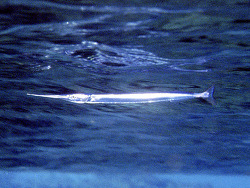Info
Belone belone (Linnaeus, 1761)
You may have noticed that, unlike in botany, only in zoology may the genus name and the species name be identical, as here with Belone belone. The common garfish feeds on small fish and swimming crustaceans as well as zooplankton.
The garfish owes its name to its long, horn-like beak.
Garfish have a worldwide distribution in all tropical, subtropical and temperate seas, in brackish and even fresh waters. The common garfish (Belone belone) lives in the eastern Atlantic, from Iceland to the Canary Islands, in the Mediterranean, in the Black Sea and in the North and Baltic Seas.
The native "common garfish" (Belone belone) grows to around one meter in length. It is a highly prized edible fish that is rarely fished commercially, but is a popular sport fish.
Although it is a good tasting food fish, it is not fished for commercially. Its poisonous green bones are striking, but you should not be put off by them. This color is caused by a chemical reaction of iron and phosphate to form vivianite, an iron(II) phosphate.
A popular spawning ground is the Greifswalder Bodden, a marginal body of water in the southern Baltic Sea between Rügen and Usedom.
Due to its size, its large swimming requirements (torpedo-shaped body) and the fact that it likes to jump out of the water, it is completely unsuitable for our reef aquariums. In large marine aquariums, such as Northern Europe's largest marine aquarium in Aarhus (Denmark), the garfish can be seen in a very large shoal in a large aquarium with a capacity of 1.5 million liters.
Synonymised names
Belone acus Risso, 1827 (synonym)
Belone bellone (Linnaeus, 1760) (misspelling)
Belone belone belone (Linnaeus, 1761)
Belone belone euxini Günther, 1866
Belone belone gracilis Lowe, 1839
Belone cornidii Günther, 1866
Belone gracilis Lowe, 1839
Belone linnei Malm, 1877
Belone longirostris Schinz, 1822
Belone rostrata Faber, 1829
Belone undecimradiata Budge, 1848
Belone vulgaris Valenciennes, 1846
Belone vulgaris Fleming, 1828
Esox belone Linnaeus, 1760 (synonym)
Hemiramphus balticus Hohnbaum-Hornschuch, 1843
Hemiramphus behnii Hohnbaum-Hornschuch, 1843
Hemiramphus europaeus Yarrell, 1837
Hemiramphus obtusus Couch, 1848
Macrognathus scolopax Gronow, 1854
You may have noticed that, unlike in botany, only in zoology may the genus name and the species name be identical, as here with Belone belone. The common garfish feeds on small fish and swimming crustaceans as well as zooplankton.
The garfish owes its name to its long, horn-like beak.
Garfish have a worldwide distribution in all tropical, subtropical and temperate seas, in brackish and even fresh waters. The common garfish (Belone belone) lives in the eastern Atlantic, from Iceland to the Canary Islands, in the Mediterranean, in the Black Sea and in the North and Baltic Seas.
The native "common garfish" (Belone belone) grows to around one meter in length. It is a highly prized edible fish that is rarely fished commercially, but is a popular sport fish.
Although it is a good tasting food fish, it is not fished for commercially. Its poisonous green bones are striking, but you should not be put off by them. This color is caused by a chemical reaction of iron and phosphate to form vivianite, an iron(II) phosphate.
A popular spawning ground is the Greifswalder Bodden, a marginal body of water in the southern Baltic Sea between Rügen and Usedom.
Due to its size, its large swimming requirements (torpedo-shaped body) and the fact that it likes to jump out of the water, it is completely unsuitable for our reef aquariums. In large marine aquariums, such as Northern Europe's largest marine aquarium in Aarhus (Denmark), the garfish can be seen in a very large shoal in a large aquarium with a capacity of 1.5 million liters.
Synonymised names
Belone acus Risso, 1827 (synonym)
Belone bellone (Linnaeus, 1760) (misspelling)
Belone belone belone (Linnaeus, 1761)
Belone belone euxini Günther, 1866
Belone belone gracilis Lowe, 1839
Belone cornidii Günther, 1866
Belone gracilis Lowe, 1839
Belone linnei Malm, 1877
Belone longirostris Schinz, 1822
Belone rostrata Faber, 1829
Belone undecimradiata Budge, 1848
Belone vulgaris Valenciennes, 1846
Belone vulgaris Fleming, 1828
Esox belone Linnaeus, 1760 (synonym)
Hemiramphus balticus Hohnbaum-Hornschuch, 1843
Hemiramphus behnii Hohnbaum-Hornschuch, 1843
Hemiramphus europaeus Yarrell, 1837
Hemiramphus obtusus Couch, 1848
Macrognathus scolopax Gronow, 1854







 Anne Frijsinger & Mat Vestjens, Holland
Anne Frijsinger & Mat Vestjens, Holland




